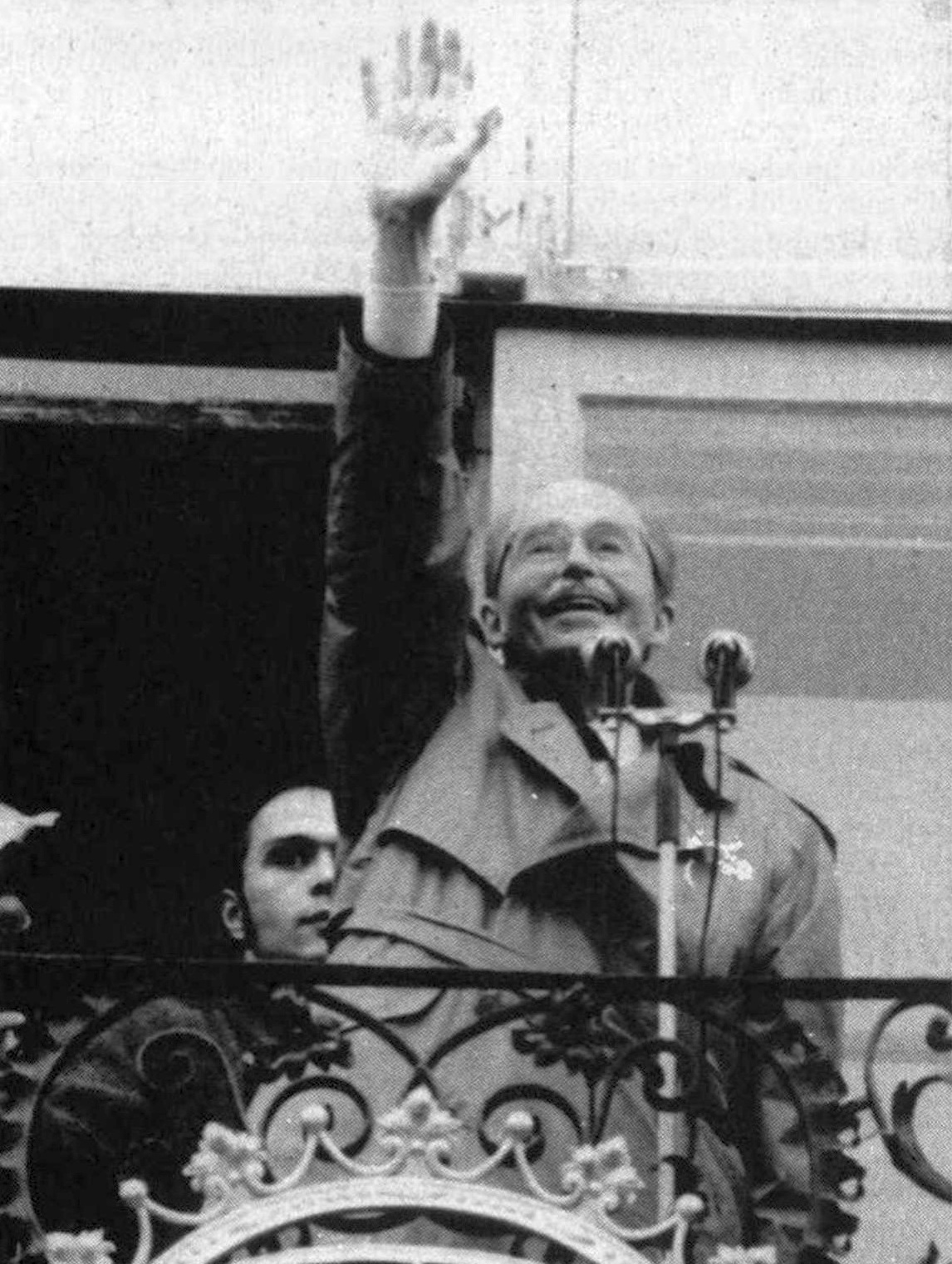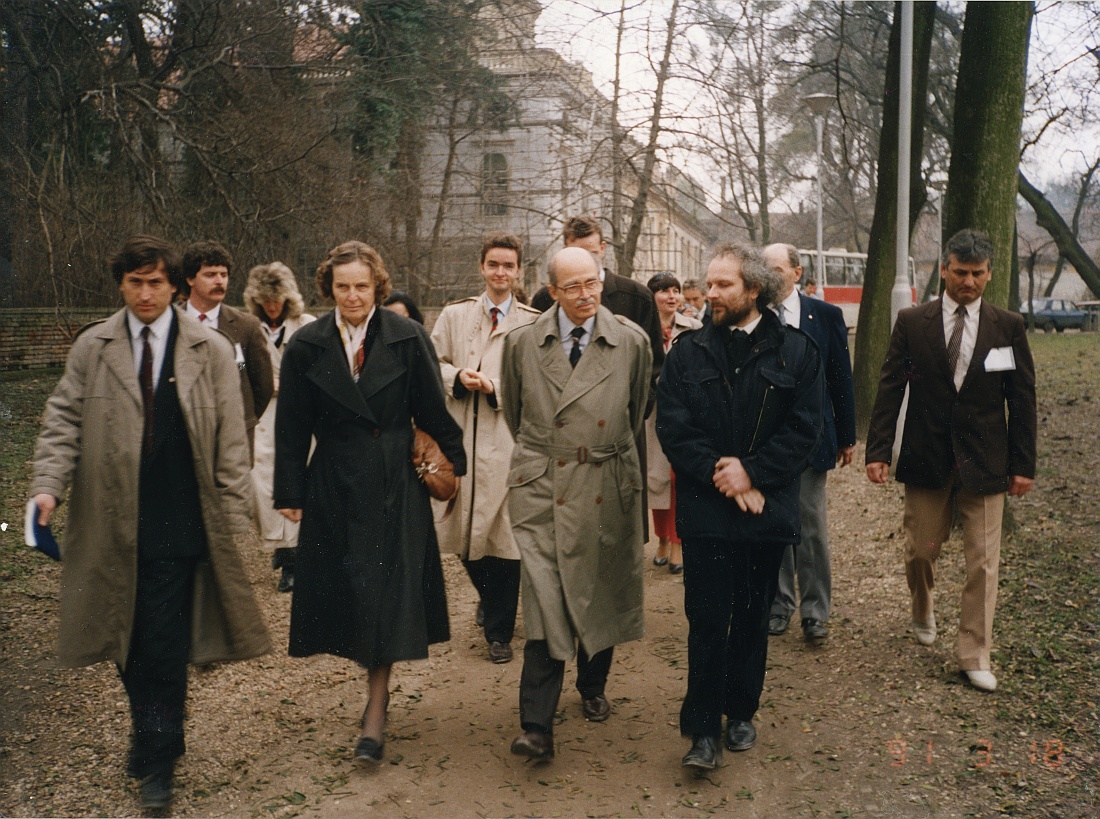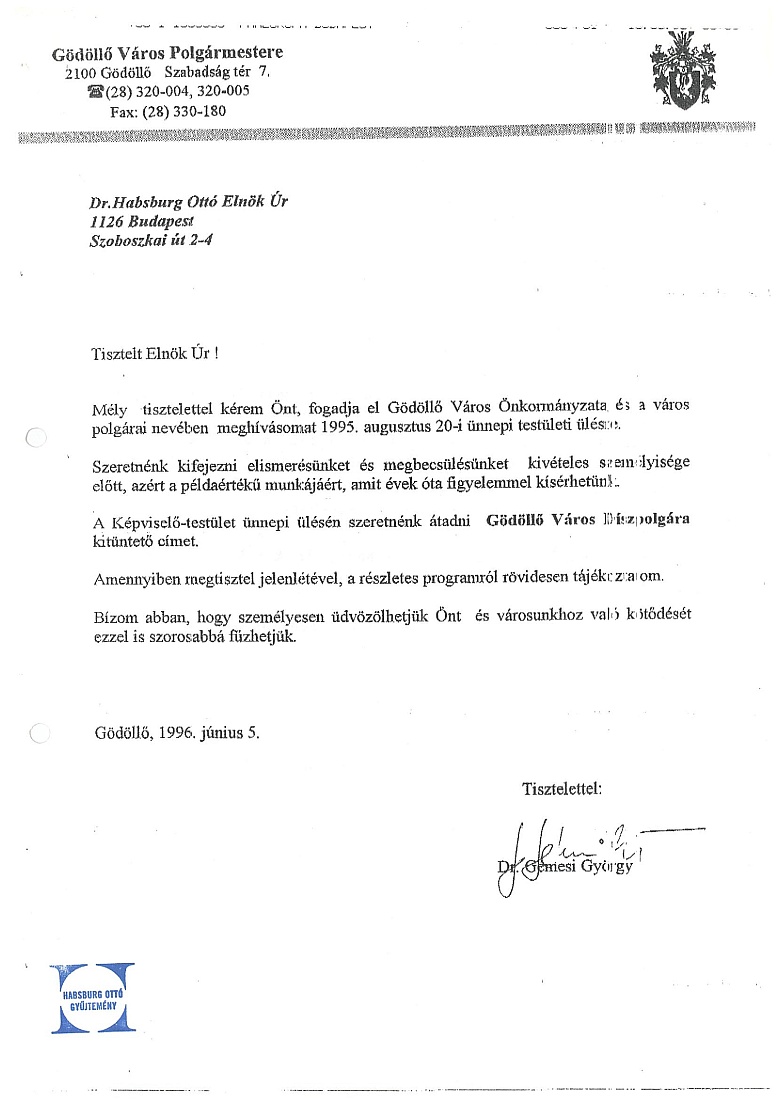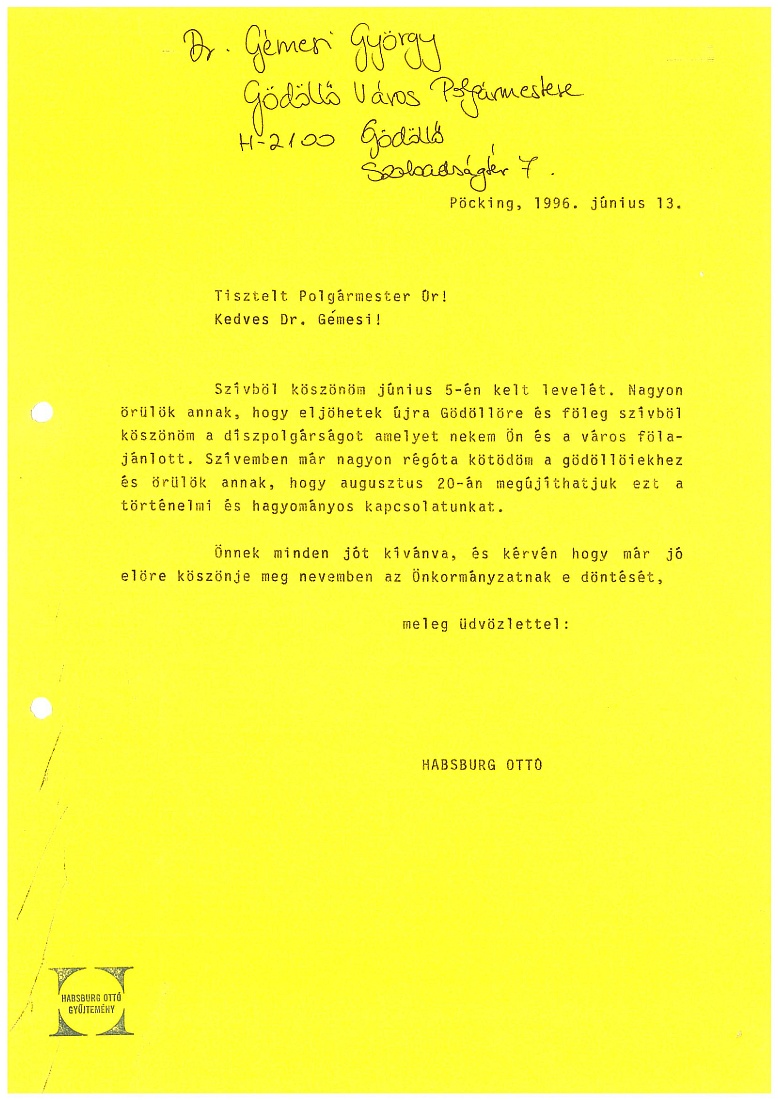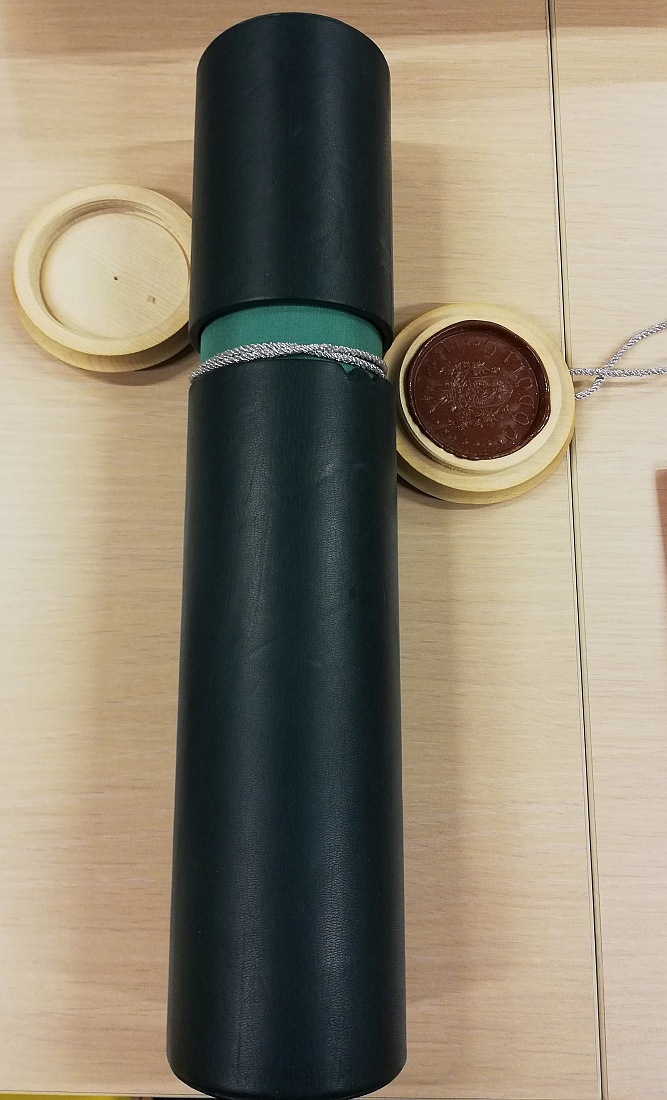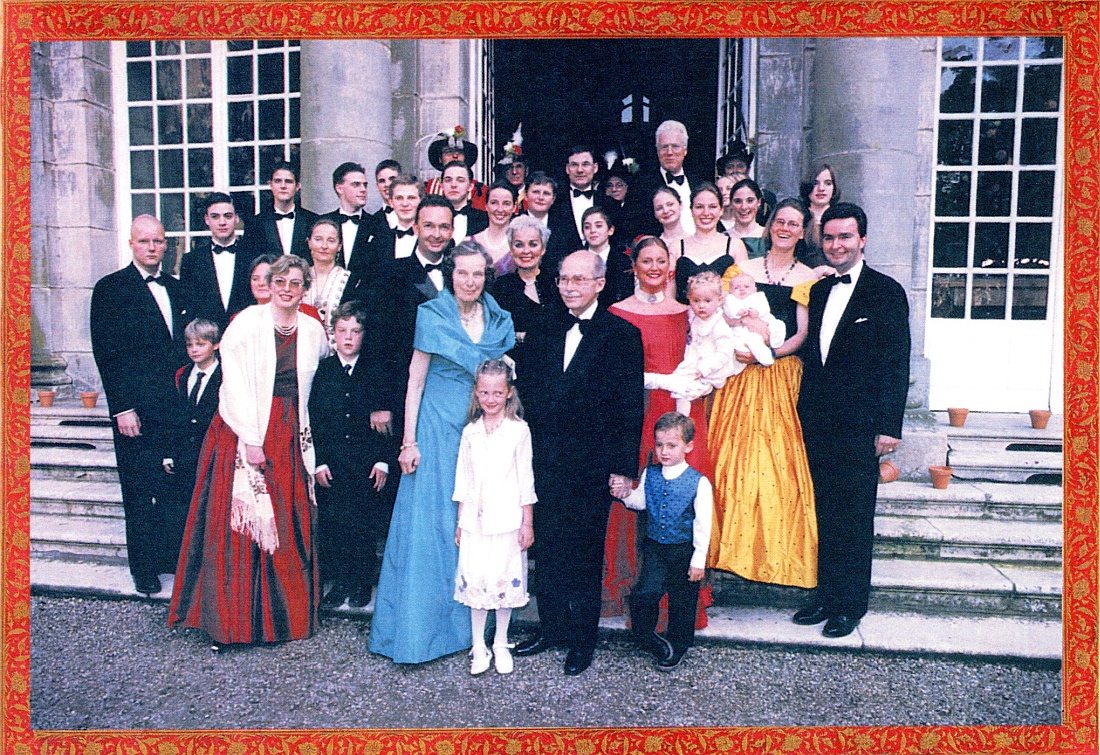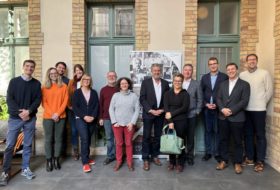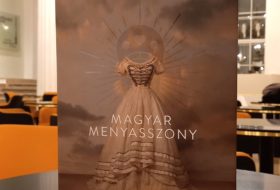„Believe me, — says the nurse,[1] her eyes lighting up, — if Otto were to be raised by true, loyal Hungarian patriots, he would make an excellent monarch.”[2] We know that it never became a reality, as he was exiled from the Austro-Hungarian Monarchy with his parents and siblings in February 1919. His last residence in Hungary was the Royal Palace of Gödöllő, where he spent nearly a week playing happily with his brothers and sisters, oblivious to the events. It was only 73 years later that he was able to see the building again, ravaged by two wars, in a dilapidated and empty state. The town of Gödöllő and the former heir to the Hungarian throne, then a European politician, truly came together when the town made him an honorary citizen 25 years ago.
Postcard from Gödöllő (c. 1918)
Otto von Habsburg was only a five-year-old boy when he visited Gödöllő for the first time with his mother, father and siblings.[3] Charles IV had already been here before: in 1917 and 1918, he spent some time encouraging soldiers convalescing in the war hospital in the castle and hunting in the nearby woods before departing for Vienna. On these occasions, he spent merely a few hours in the village.
A longer stay was first contemplated in the summer of 1918. The idea came from Baron Joseph Szterényi[4], who thought it would be appropriate for his king to tour his second homeland, therefore a visit to Szeged and Debrecen was added to the programme. Charles accepted the Baron’s proposal and commissioned him to organise a trip that included a 6-8 week visit to Gödöllő. The travel to Hungary finally took place in October 1918.
By then, the Monarchy was showing signs of disintegration. The sense of impending demise had left its mark on the royal couple’s visit to Debrecen, even though it was an attempt to evoke the “happy times of peace”.[5]
The imperial train left for Hungary on 23 October. The royal children were also scheduled to visit Debrecen, but their parents ended up leaving them in Gödöllő with their guardians, Countess Kerssenbrock[6] and Sister Melitta.[7] However, the trip to Szeged, planned for 30 October, could not be carried out.[8]
On 24 October, it would have appeared to everyone that the family had arrived for an extended stay in Gödöllő.[9] They attended mass daily in the castle chapel and participated in the devout recitation of the Holy Rosary. However, the situation was changing by the minute; although court etiquette was not as rigid as before, Hungarian troops were sent to Gödöllő to ensure the monarch’s and his family’s safety.[10] Meanwhile, the resignation of the Wekerle government meant that Charles was working on setting up a new government and saving the Monarchy.[11]
On 26 October, Charles IV received Mihály Károlyi at the Royal Palace and took him to Vienna, where he was called to resolve the crisis in the Viennese government. Queen Zita, who wished to remain by her husband’s side at this critical time, travelled with the king. That is how it could come about that „at around 10 o’clock on the night of the 26th, they boarded the special train together, believing they would return to Gödöllő in a few days. They did not even take the children, who remained in the castle with their chaperons and a detachment of security guards.”[12] It was common for the royal children that their parents were sometimes called away from them for a few days by state matters. Because of their age, they were not informed of the Monarchy’s affairs and the Great War’s developments. Except for the five-year-old heir, who was told about the fateful events in a child’s language.[13]
Otto with his siblings (1917)
The Royal Couple’s return to Hungary on 30 October was rendered impossible by the turn of events. The children were probably unaware of the situation, as their educators always arranged some activity for them. Their safety was the responsibility of Captain Ferenc Walla[14], who was given orders to leave with the children straightaway in case of any danger. The captain phoned the capital several times a day to inform himself of events and made plans for the safest way to get the royal children out of the country.[15] There was no alarming news from the capital, even though Budapest resembled a volcano about to erupt by then.
On the night of 31 October, Count Joseph Hunyady[16] called Captain Walla from Vienna puzzled. „Are you still in Gödöllő? Don’t you know that the revolution has broken out in Budapest? You and the children must take off immediately for Vienna, and I will travel from here to meet you.” The preparations for the journey began immediately in the castle, even more so because they received news that soldiers had set out from the capital towards Gödöllő. The children were woken up, and the automobiles were prepared.[17] The convoy set off at 7 a.m.[18] Captain Walla sat with a loaded gun beside the driver in the first military carriage to protect the royal children and their guardians in the royal vehicle after them. Behind him travelled the court chaplain, Prelate Seydl and Count Attems, the Queen’s chamberlain. The Queen’s brother, Prince René of Bourbon-Parma, drove the royal automobile. The members of the entourage and a few guards occupied the other two cars.[19] To avoid the capital, they took the Vác-Léva-Nyitra route to Vienna, with Count Hunyady waiting for them at the Vág Bridge in Szered. There were no significant difficulties on the way, and by evening, they had reached Vienna without any issues, much to the relief of the anxious royal parents.[20]
Interestingly, Otto von Habsburg remembers these days mainly as a ‘car ride’, which was more thrilling for him than the days spent in the castle.[21] Many people considered this period to be very dangerous. This is perhaps demonstrated by the fact that they set out for Vienna in several carriages, and the last one had petrol in it in case something occurred; by setting fire to this vehicle, the other three could continue their journey safely.[22]
Otto von Habsburg visiting Gödöllő (18 March 1991)
After the sorrowful ending of his days at Gödöllő, Otto von Habsburg, at the invitation of Lutheran pastor and Member of the Parliament Gábor Roszik, returned to the town on 18 March 1991.[23] Accompanied by his wife Regina and his sons Karl and Georg, at the mayor’s office, he met his host for the first time, the mayor, György Gémesi, and members of the town’s council and other guests. It was an important day for him „because – as he said – it is my first visit to Gödöllő since November 1918. For a long time I could not have imagined that this visit could ever happen!” In his speech, he also emphasised that he was optimistic about the future of Hungary. At the end of the meeting, Father Fidél, head of the Capuchin monastery in Máriabesnyő, located near the castle, read documents from the monastery’s 1918 yearbook about the last days of the royal family in Gödöllő and their forced escape. Otto von Habsburg and his family were moved by what they heard.
The next event was held in the Royal Palace, a gift from the Hungarian nation to Franz Joseph and Queen Elisabeth on the occasion of their coronation in 1867. Even in ruins, the castle impressed its long-lost acquaintance. Art historian Ferenc Dávid showed the guests around the building and explained its restoration and utilisation plans. Following the tour, Otto von Habsburg, from the balcony of the Banqueting Hall, greeted the hundreds of Gödöllő residents who had come to pay their respects. His speech here also had a positive vision for the future: „Forty years of destruction cannot be repaired in a single year. We are facing a challenging period, but I know we will succeed. I will do my utmost to make this prosperous future reality as soon as possible.”His words were greeted with a round of applause.
Otto von Habsburg on the balcony of the Royal Palace of Gödöllő (18 March 1991)
At noon, a press conference was held in the former office of Franz Joseph, during which the representative of the region’s parliament welcomed the participants. Gábor Roszik spoke about the good relations between the royal family and the people of Gödöllő and about Otto von Habsburg’s work as President of the Pan-European Union. Mayor György Gémesi outlined the plans for the use of the palace. A local proposed to build a residence for Otto von Habsburg and his family.
Otto von Habsburg was optimistic about the castle’s future, despite its crumbling walls. As he said, „this is just the present, and the future is promising”. He also pledged to do his best to ensure that the castle was restored rapidly. The family eventually left Gödöllő in the early afternoon.[24]
The former heir to the throne received continuous information from the director Kálmán Varga about the renovation works of the castle and the various interior design. They also planned to involve him in the organisation of the exhibitions,[25]but according to Georg von Habsburg, his father did not want to interfere with professional matters. His only idea was to let part of the exterior wall untouched to show where the renovation began and what had been achieved during the reconstruction.[26]
Letter of request for citizenship of Honour to Otto von Habsburg, response letter, and honorary citizenship certificate
Perhaps the most memorable moment of the intertwinement of the town and the politician’s life was when Otto von Habsburg received the title of honorary citizen of Gödöllő on 20. August 1996. In May 1996, the Council of Representatives created a decree establishing local honours. The title of honorary citizen was conferred to Otto von Habsburg in recognition of his family’s historical ties with Gödöllő and his exemplary work over several decades in the creation of modern Europe.[27] The decision was announced to the former heir to the throne by Mayor György Gémesi in a letter in June, which he accepted with great pleasure.[28] In his speech, the honouree said,„Gödöllő has played an enormous role in my life, and now, as a senior Hungarian, I recall that I was here in Hungary for the last time before my seventy-year emigration”. He expressed his gratitude, „that I can now legally call myself a Gödöllő citizen”. The mayor, also conveying the joy of the people of Gödöllő, said:„We are happy that a citizen of Gödöllő is now sitting in the European Parliament.”[29] After the inauguration ceremony, a reception was held in the banqueting hall of the Gödöllő castle in honour of Otto von Habsburg and his family, followed by a tour of the building’s rooms.[30]
It was a day of festivities for Otto von Habsburg and the people of Gödöllő as well, as the castle was opened to the public.[31] At that time, one could only hope for what we now know: the Royal Palace of Gödöllő, the name of which still evokes the “happy times of peace”, has become one of Hungary’s most visited tourist destinations.
Group photo and signed card of gratitude on the occasion of the 50th wedding anniversary of Otto von Habsburg and Archduchess Regina
There are two more significant events worth mentioning. The first is the 50th wedding anniversary of Otto von Habsburg and Archduchess Regina, which was celebrated in Nancy and later in Gödöllő in 2001. Georg von Habsburg and his wife, Archduchess Eilika, organised the festivities in Hungary. At the request of Archduchess Regina, Joseph Szendi,[32] former Archbishop of Veszprém, celebrated the mass. At his recommendation, the event in Hungary was held on the Solemnity of the Ascension of Jesus Christ (also called as Ascension Day or Ascension Thursday). The Archpriest was probably asked to celebrate the mass not only because of the personal good relationship, but also because of tradition.[33][34]
After the mass, at a ceremony in the palace’s banqueting hall, Georg von Habsburg described his parents’ marriage as exemplary and an inspiration for all to follow. In turn, Otto von Habsburg stressed the importance of family values for the stability and peace of marriage. He also revealed the secret of a good marriage: „discuss everything openly, but keep the community”. In his opinion, if couples keep these principles in mind, fifty years will pass very quickly.[35]
The final, no less significant event is Otto von Habsburg’s 90th birthday. On 24. November 2002, the President of the Republic, Ferenc Mádl, greeted the celebrant in Gödöllő. „As the embodiment of the European ideal, we owe a lot to Otto von Habsburg, who represents the deep faith and love for Hungary”. He also underlined that the politician’s steadfast work over the past decades had made an unparalleled contribution to the restoration of European unity and the widespread realisation of the values of the European idea, freedom and democracy. As a member of the European Parliament, he successfully fought for the peoples of Central Europe – including Hungary – to regain their independence.[36] The last Hungarian heir to the throne was greeted not only by Ferenc Mádl but also by the government, parliamentary parties, cultural and scientific circles, churches, media leaders and representatives of the diplomatic corps.[37]
Regretfully, no further visit took place. As President of the Pan-European Union, however, he was delighted that the Royal Palace of Gödöllő was chosen as the main venue for the 2011 meeting during Hungary’s EU Presidency.[38] He rightfully saw this as a fitting tribute to his six decades of efforts for European unity.
Anett Nacsa
[1] Melissa Gubicza (Mária Gubicza), nun, member of the Congregation of the Daughters of Divine Love, and tutor of Otto von Habsburg and his siblings from 1916.
[2] Miklós Radnai: On the birthday of King Otto II. A solemn mass at the Basilica – The entire Hungarian society prayed for the hereditary king and the ancient constitution. Nemzeti Újság, 21. November 1922, 1
[3] Ibid.
[4] József Szterényi (József Stern) (1861-1941), baron, Hungarian politician of Jewish origin, Minister of Trade.
[5] According to Charles, “it was such a strange and idiotic thing that in the moments of doom, when the Monarchy, the great Tower of Babel, was about to collapse, they brought the king to celebrate”. Kálmán Varga: The last stay of the royal family in Gödöllő (October 1918), Hitel, 1993, 11, 61. (hereafter Varga (1993))
[6] Korff-Schmising-Kerssenbrock, Countess Theresa (1888-1973), lady-in-waiting to Queen Zita, governess to the royal children.
[7] Correct: Sister Melissa, probably a nickname.
[8] After the visit to Debrecen, the royal couple returned to the Royal Palace in Gödöllő. Halfway there, they stopped the train for telegraph connections to inform Charles of the fall of Fiume and the resignation of the Wekerle government. The train did not arrive at Gödöllő station until 11 p.m. Freiherr von Werkmann, Karl: Otto von Habsburg. Berlin-Wien-Leipzig, 1932, p. 61 (hereafter Werkmann (1932)).
[9] Varga (1993), 62.
[10] Ibid. The commander of the group, which mainly consisted of volunteers for a year, was Captain-General Ferenc Walla.
[11] The emperor wanted to consult with all possible politicians, so the castle looked like a ministry’s waiting room during this period.
[12] Varga (1993), 65.
[13] Habsburg Ottó Alapítvány, Habsburg Ottó Gyűjtemény, Fotó- és audiovizuális gyűjtemény, Hangzó dokumentumok HOAL I-5-f K06 Die Erinnerungen der Marie Therese Gräfin Kerssenbrock – Politik aus der Kinderzimmerperspektive 1918–1922
[14] Ferenc Géza Walla (1887-1961), Captain of the General Staff. He was awarded the title of Signum Laudis for his courage in the war against the enemy.
[15] Werkmann (1932), 63-64. The route planning included safe and side roads.
[16] Imre Hunyady (1873-1942), count. Charles IV’s aide-de-camp, then High Seneschal. He assisted the king in his attempts to return to Hungary and followed him into exile.
[17] Werkmann (1932), 67-68. The four automobiles consisted of one military, one royal and two escort vehicles. The crown crests were removed before departure, and enough petrol was provided to make the 300-kilometre journey without any problems.
[18] Varga (1993), 66.
[19] Werkmann (1932), 68.
[20] Werkmann (1932), 71.
[21] Telephone interview by the author with George von Habsburg, 9. July 2021.
[22] Otto von Habsburg Foundation, Collection of the Otto von Habsburg Foundation, Digital Collection, Foundation for the Promotion of Hungarian Moving Image Treasures HOAL II-4-b Péter Bokor-Gábor Hanák, Gödöllő, 18. May 1998, 00:03:01.
[23] Otto von Habsburg Foundation, Otto von Habsburg Collection, Correspondence, Hungarian-language correspondence of Otto von Habsburg 1988-2011 HOAL I-2-c-Gábor Roszik 10 August 1990.
[24] Éva Pillér: Otto von Habsburg in Gödöllő. European House in the palace. Pest Megyei Hírlap, 19 March 1991, 2.
[25] HOAL I-2-c Kálmán Varga 25. September 1990.
[26] Telephone interview of the author with George von Habsburg, 9. July 2021.
[27] http://kontraszt.godollo.hu/hirek/hirek/index.php?newswf2_action=print&newswf2_id=46208 (Date of download: 02.08.2021)
[28] HOAL I-2-c-György Gémesi 5. June 1996; 13. June 1996.
[29] Honorary citizen of Gödöllő Otto von Habsburg. Pest Megyei Krónika, 23 August 1996, 1.
[30] HOAL I-2-c-György Gémesi 5. June 1996; 13. June 1996.
[31] The main wing of the Grassalkovich Castle in Gödöllő shines again. Six billion forints are still needed for completion – The riding school and the park are overdue. Pest Megyei Krónika, 23. August 1996, 1.
[32] József Szendi (1921-2017), Archbishop of Veszprém
[33] Traditionally, since Queen Gizella, Hungarian queens have been crowned by the bishops of Veszprém. Veszprém became an archdiocese in 1993.
[34] Zsuzsa Dallos. Habsburg Golden wedding anniversary. Napló, 26. May 2001, 5.
[35] Habsburg Golden wedding anniversary in Mariazell. Magyar Szó, 31. May 2001, 14.
[36] Greeting Otto von Habsburg. Népszabadság, 25. November 2002, 5.
[37] Otto von Habsburg 90. Vasárnap Reggel, 24. November 2002, 2.
[38] Telephone interview of the author with George von Habsburg, 9. July 2021.
